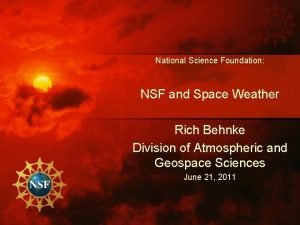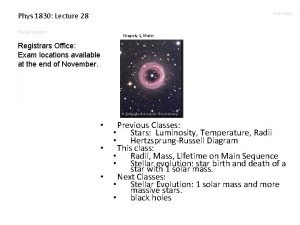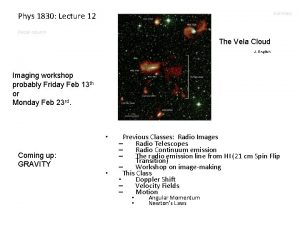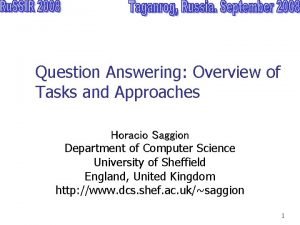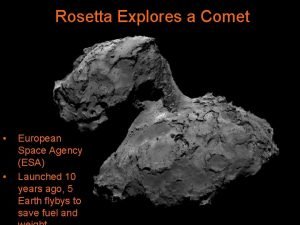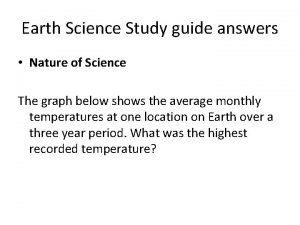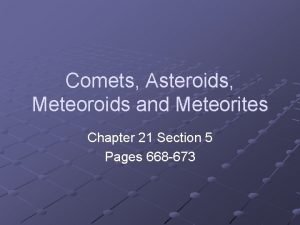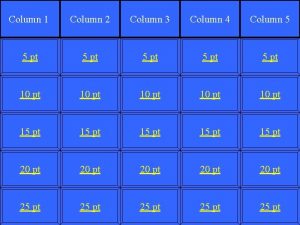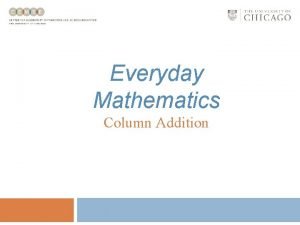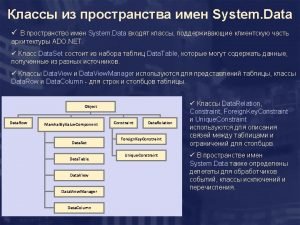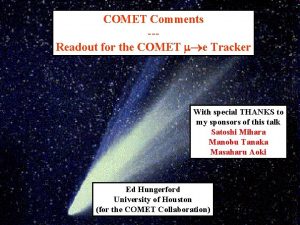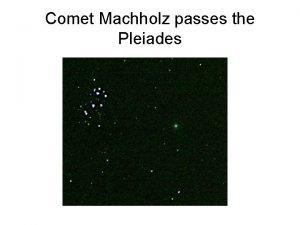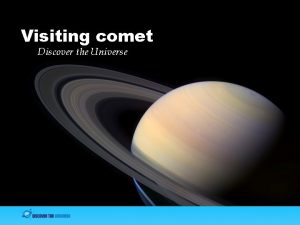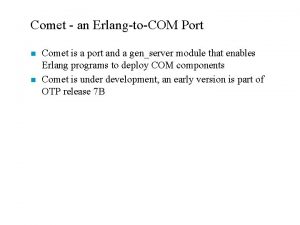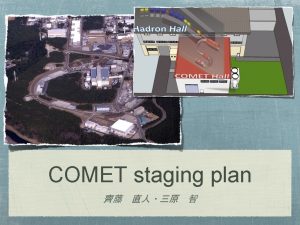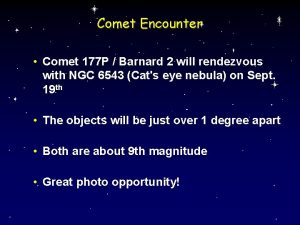SDO Recall column summary summary Recall column Comet
























- Slides: 24

SDO Recall column summary

summary Recall column Comet ISON – closest approach Dec 26

APOD: Solar Eclipse Flash spectrum summary Recall column • Diffraction grating spectrum • Not absorption lines! Lower part of atmosphere blocked by moon. • Chromosphere emission line individual images – H_alpha on right.

summary Phys 1830: Lecture 26 Recall column NASA’s Solar Dynamics Observatory: Extreme Ultra. Violet wavelengths Image Workshop! Dec 3 at 7 -10 pm Allen Building • Take up test on Monday new password • • Previous Classes: – The Sun This Class • The Sun • Greenhouse Effect – Stars • Luminosity • • • Radii, Mass Lifetime Stellar Populations Upcoming Classes – Stars

The Sun summary Recall column Unexpectedly the atmospheric temperature increases with distance from the core! Probably caused by disturbances in the Sun’s magnetic field. • The photosphere is the visible "surface" of the Sun. • Below it lie the convection zone, the radiation zone, and the core. • Above the photosphere, the solar atmosphere consists of the chromosphere, the transition zone, and the corona

Solar Flares and Coronal Mass Ejections summary Recall column • • • Green: solar flare -- can also be seen in X-ray (100 million K) – Flash across region in minutes and blast into space. Red: coronal mass ejection – Giant magnetic bubbles of ionized gas separating from the solar atmosphere. – Occur weekly at sunspot mininum and a few times a day at maximum. Blue: proton shower – recall fast moving particles are called cosmic rays.

Solar Wind summary Recall column • Continous stream of electromagnetic radiation and cosmic rays. 1. from high in corona where gas is hot enough to escape. 2. From coronal holes – regions where magnetic field loops snap and extend into space.

SDO – 2 instruments & many filters stellar components Recall column summary

The Realm of Belief: The World Will End 2012 Recall column summary SOHO/ESA/NASA • Some 2012 fears are related to solar activity at the peak of sunspot activity. – The peak is predicted to occur in 2013 (not 2012) by NOAA’s SWPC.

Earth’s Magnetosphere: summary Illustration Recall column • The Earth's magnetic field is complicated and will protect life even if a polarity shift was occurring. • However solar activity does disrupt satellite communications and power networks.

Influence of the Sun: The edge of the Solar System? (No) Recall column summary Solar Wind: The sun exhales a thin, hot wind of electrically conducting gas, called plasma, into space at about 1. 5 million km per hr. • Heliosphere: The solar wind forms a large plasma bubble as the sun orbits in our Galaxy. The heliosphere has an inner and outer region. • Termination Shock: The thin, invisible boundary of the inner, solar wind region. – The solar wind abruptly drops in speed at the termination shock estimated between 80 – 100 AU (i. e. within the Kuiper Belt). – Voyagers 1 & 2 have crossed the termination shock. • Heliopause: Termination of the heliosphere. – Separates the solar material from the interstellar medium. – Estimated between 120 to 150 AU – IBEX is studying the heliosphere boundaries. – Voyager 1 crossed boundary at 125 AU • Bow Shock

Sun’s Influence: On Earth summary Recall column Recall Inverse Square Brightness Law

Sun’s Influence: On Earth summary Recall column • The sun’s luminosity is equivalent to the detonation of 10 billion 1 -megaton nuclear bombs per second. • When this energy reaches the earth 30% is intercepted by the atmosphere. • 0 -20% reflected by the clouds. • A sunbather receives the equivalent of 5 100 -Watt light bulbs.

Sun’s Influence: On Earth summary Recall column • The relationship between earth and the sun is complex and is a frontier of research. • Can this lead to climate change? • The solar cycle leads to an increase in solar luminosity of 0. 2 -0. 3 % during the peak. • This cycle could lead to weather patterns, but they are weaker than those caused by El Nino or volcanic dust.

Sun’s Influence: On Earth summary Recall column • Intergovernmental Panel on Climate Change. IPCC won Nobel Prize. • Thousands of scientists from all over the world contribute to the work of the IPCC on a voluntary basis. • See the IPCC summary and FAQ. • http: //www. ipcc. ch/report/ar 5/wg 1/#. Uo. Zuz 6 WLlj. E • http: //www. climatechange 2013. org/images/u ploads/WGI_AR 5_SPM_brochure. pdf • Climate Skeptic now says there is global warming: http: //online. wsj. com/article/SB 1000142405297020442240 4576594872796327348. html

Sun’s Influence: On Earth summary Recall column • Solar luminosity contribution to global warming (blue line above) is small. • Note the increase in greenhouse gases (since the industrial revolution ~ 1750)

Sun’s Influence: On Earth summary Recall column • Details about these plots: • • • The black line is based on data – i. e. what is measured. The temperature increase is happening. Recall that simulations use the laws of physics and assumptions. Therefore there are uncertainties. These uncertainties generate the width of the blue and pink regions. Modelling just the natural forces that can make the temperature change shows that the temperature would be rather stable – the horizontal blue region. This includes the variation in luminosity of the sun. Modelling both the natural forces and the impact of human beings generates the pink region – note how large the uncertainties are. The width of this region shows uncertainties and variations between models are not being ignored. Note how the models with both natural forces and the impact of human beings are better at matching the observations.

Sun’s Influence: On Earth summary Recall column • These are measurements over time of the amount of each of these green house gases. • Notice that there are error bars to mark the uncertainty. • Notice that the “spike” is much higher in value than the uncertainties in the measurement. That is, it is not an error.

New IPCC report – trends continue Recall column summary

Sun’s Influence: On Earth summary Recall column Summary: The sun has influence throughout the solar system and our distance from it allows liquid water. However the solar cycle and activity is not responsible for global warming. Human activity is a likely cause. �� • Check the King’s Centre for Visualization in Science for interactives on climate change: http: //www. kcvs. ca/site/projec ts/climate. html

Stars: Their Characteristics Recall column • Luminosity: energy output • Temperature • Size summary

Stars: Their Characteristics Recall column summary Recall Inverse Square Brightness Law Luminosity, or absolute brightness, is a measure of the total power radiated by a star. Apparent brightness is how bright a star appears when viewed from Earth; it depends on the absolute brightness but also on the distance of the star.

Luminosity and Apparent Brightness Therefore, two stars that appear equally bright might be a closer, dimmer star and a farther, brighter one:

More Precisely 17 -1: More on the Magnitude Scale Apparent brightness when measured using a logarithmic, magnitude scale, which is related to our perception is called apparent magnitude. Absolute magnitude is the apparent magnitude that a star would have if it were placed 10 parsecs from Earth. A reduction of 5 in magnitude corresponds to an increase in a factor of 100 in luminosity. Magnitudes are inverted in scale, such that bright stars have low magnitudes. Converting from magnitude to luminosity in solar units: This graph allows us to perform this conversion simply by reading horizontally.
 Yuzhnoye sdo
Yuzhnoye sdo Sdo datt
Sdo datt Sdi sdo miso mosi
Sdi sdo miso mosi Sdo
Sdo Main screen login
Main screen login Elli sdo
Elli sdo Accounting worksheet example
Accounting worksheet example Recall column
Recall column Recall column
Recall column Velacloud
Velacloud Euler formula for column
Euler formula for column What is gravity
What is gravity The diagram below shows the path of a comet around the sun
The diagram below shows the path of a comet around the sun Pilgrimage churches romanesque
Pilgrimage churches romanesque Answers
Answers Comet sistem
Comet sistem Comet electrical
Comet electrical Comet knowledge graph
Comet knowledge graph Right side up agency
Right side up agency Inspirational leader mohandas gandhi phrase or clause
Inspirational leader mohandas gandhi phrase or clause Comet pressure wire
Comet pressure wire Alliteration in song lyrics
Alliteration in song lyrics Halley's comet size
Halley's comet size Nature of science study guide
Nature of science study guide Comet parts
Comet parts



